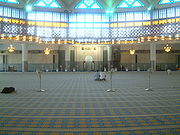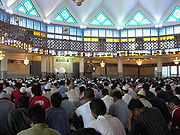
Masjid Negara
Encyclopedia



Kuala Lumpur
Kuala Lumpur is the capital and the second largest city in Malaysia by population. The city proper, making up an area of , has a population of 1.4 million as of 2010. Greater Kuala Lumpur, also known as the Klang Valley, is an urban agglomeration of 7.2 million...
. It has a capacity of 15,000 people and is situated among 13 acres (52,609.2 m²) of beautiful gardens. The original structure was designed by a three-person team from the Public Works Department
Malaysian Public Works Department
Malaysian Public Works Department ' or Jabatan Kerja Raya Malaysia ' is the federal government department in Malaysia under Malaysian Ministry of Works which is responsible for construction and maintenance of public infrastructure in Malaysia such as federal and state roads, public government...
- UK architect Howard Ashley, and Malaysians Hisham Albakri and Baharuddin Kassim. The mosque was built in 1965 on the site of a church, the Venning Road Brethren Gospel Hall which had stood there since 1922 but appropriated by the Malaysian government. The mosque is a bold and modern approach in reinforced concrete, symbolic of the aspirations of a then newly-independent Malaysia.
Its key features are a 73-metre-high minaret and an 16-pointed star concrete main roof. The umbrella, synonymous with the tropics, is featured conspicuously - the main roof is reminiscent of an open umbrella, the minaret's cap a folded one. The folded plates of the concrete main roof is a creative solution to achieving the larger spans required in the main gathering hall. Reflecting pools and fountains spread throughout the compound.
History
Malaya gained its independenceIndependence
Independence is a condition of a nation, country, or state in which its residents and population, or some portion thereof, exercise self-government, and usually sovereignty, over its territory....
from the British
United Kingdom
The United Kingdom of Great Britain and Northern IrelandIn the United Kingdom and Dependencies, other languages have been officially recognised as legitimate autochthonous languages under the European Charter for Regional or Minority Languages...
government on 31 August 1957. Major development programs in areas of economy, social and architecture were actively implemented in line with the new government. The programs were also to portray new progressive culture and achieved democracy. Therefore, on 30 July 1957, in the meeting of the Federal Executive Council an idea to build a national mosque as a symbol of the country’s independence was mooted. In another meeting on 5 March 1958, Chief Ministers of the eleven states in the Federation of Malaya
Federation of Malaya
The Federation of Malaya is the name given to a federation of 11 states that existed from 31 January 1948 until 16 September 1963. The Federation became independent on 31 August 1957...
, a proposal was made to name the mosque Masjid Tunku Abdul Rahman Putra Al-Haj, in recognition of Yang Teramat Mulia Tunku Abdul Rahman Putra Al-Haj’s efforts in guiding the country to gaining independence. However, Tunku refused this honour; on the contrary he named it Masjid Negara in thanksgiving for the country’s peaceful independence without bloodshed .
The mosque underwent major renovations in 1987, and the once-pink concrete roof is now clad in green and blue tiles. Today, Masjid Negara continues to stand sleek and stylish against the Kuala Lumpur skyline. An underground passage leads to the National Mosque located near the railway station
Kuala Lumpur Railway Station
Kuala Lumpur Railway Station is a train station located in Kuala Lumpur, Malaysia. Completed in 1910 to replace an older station on the same site, the station was Kuala Lumpur's railway hub in the city for the Federated Malay States Railways and Malayan Railway , before Kuala Lumpur Sentral...
, along Jalan Sultan Hishamuddin. Its unique modern design embodies a contemporary expression of traditional Islamic art calligraphy and ornamentation. Near the mosque is the Makam Pahlawan
Makam Pahlawan
The Makam Pahlawan is the burial ground of several Malaysian leaders and politicians. It is located near the Malaysian national mosque, Masjid Negara in the national capital, Kuala Lumpur...
(Heroes' Mausoleum), a burial ground of several Malaysian politicians. Makam Pahlawan is a 7-pointed star concrete roofed structure.
Imams of Masjid Negara
- Haji Ghazali Abdullah (1965)
- Hj. Mohd Salleh Hassan Farid
- Datuk Sheikh Abdul Mohsein ibn Hj. Salleh (1974-1975)
- Dato' Hj. Ahmad Shahir ibn Haji Daud (1975-1980)
- Dato' Hj. Hassan Din Al-Hafiz (1981-1983)
- Dato' Hj. Ahmad Shahir ibn Haji Daud (1984-1992)
- Haji Arifin Harun (1992-1993)
- Haji Taib Azamudden Md. Taib (1993-1999)
- Haji A. Jalil ibn Sindring (1999-Sep. 2001)
- Haji Wan Halim ibn Wan Harun (2001-2004)
- Dato' Haji Kamaruddin ibn Hj Zakaria (2005-2006)
- Tan Sri Dato' Syaikh Hj.Ismail ibn Hj.Muhammad (February 2007-current.)
See also
- Timeline of Islamic history
- Islamic architectureIslamic architectureIslamic architecture encompasses a wide range of both secular and religious styles from the foundation of Islam to the present day, influencing the design and construction of buildings and structures in Islamic culture....
- Islamic artIslamic artIslamic art encompasses the visual arts produced from the 7th century onwards by people who lived within the territory that was inhabited by or ruled by culturally Islamic populations...
- List of mosques
- Islam in MalaysiaIslam in MalaysiaMalaysia is a multiracial country with Islam being the largest practiced religion, comprising approximately 61.4% Muslim adherents, or around 17 million people, as of 2010. Islam is declared as the "religion of the federation". Though there has been much debate on whether Malaysia is a secular...
External links
- Masjid Negara Homepage
- KL Heritage Trail: Masjid Negara KL Heritage Trail: Masjid Negara @ National Mosque

